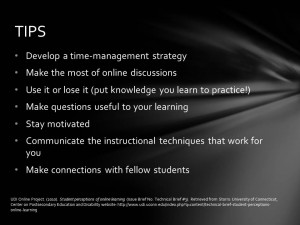“Distance delivery is and will continue to have an impact on education in the years to come” (Schmidt & Gallegos, 2001, p. 2).
In thinking and researching about future perceptions of distance learning, the two challenges that came up over and over again had to do with being “unsatisfied when they are unfamiliar with the technology used in the course” (UDI Online Project, 2010, p. 2) and isolation. While many people are online (using social media, emailing, etc.), there are many who do not know how to use specific technology tools. I know from my experience as a teacher that just the “simple act” of attaching a file to an email is unknown to many. If we are to begin to change anyone’s perception of online/distance learning, we need to acknowledge that, for some students, the process must begin with an orientation to the different tools being used within a hybrid/online course.
The other side of the story is the benefits that can be gained from taking courses online, such as:
- “the variety and quality of learning materials available” (UDI Online Project, 2010, p. 1)

- the “wealth of resources available to help students develop critical thinking skills” (UDI Online Project, 2010, p. 1)
- the “design of the course, comfort with online technologies, and time management” (Song, Singleton, Hill, & Koh, 2004, p. 65)
- being “helpful not to have to travel to the campus” (Song, Singleton, Hill, & Koh, 2004, p. 65)
- the “ability to complete assignments and tasks at any time” (Song, Singleton, Hill, & Koh, 2004, p. 65).
As instructional designers, we must look at the benefits, look at our course materials, work with the subject matter expert, and create a learning environment that enables our students to be successful. “Successful conversion of course delivery method is not always guaranteed” (Schmidt & Gallegos, 2001, p. 1). We cannot simply take an existing face-to-face course, move it to an online format, and assume it will work. As the industry grows, if we create online learning opportunities for students to be successful, this type of learning will become even more mainstream.
The other major challenge had to do with students feeling isolated when taking a course. “When developing a distance delivery course, course designers must provide a way for students and instructor to interact” (Schmidt & Gallegos, 2001, p. 5). It begins with a teacher/professor making the student feel welcomed into the online environment. Instructional designers need to create tasks (discussion boards, group projects, etc.) that encourage communication among students. Once these are created, the teacher/professor needs to respond in a timely manner to the different assignments, emails, journal entries, and discussion posts. If these are all monitored and responded to, students will feel as if there is a community of learners being built, and the isolation will not be felt as deeply by the students.
 “The constant growth of the Web influences and changes how online courses are designed and implemented” (Song, Singleton, Hill, & Koh, 2004, p. 60). As instructional designers, we must strive to keep up with these changes and to constantly look forward to see what the “next best thing” might be. Research is constantly being completed as to the impact of online, hybrid, and face-to-face education. We must keep up with this research as best we can so we can implement effective processes within our courses.
“The constant growth of the Web influences and changes how online courses are designed and implemented” (Song, Singleton, Hill, & Koh, 2004, p. 60). As instructional designers, we must strive to keep up with these changes and to constantly look forward to see what the “next best thing” might be. Research is constantly being completed as to the impact of online, hybrid, and face-to-face education. We must keep up with this research as best we can so we can implement effective processes within our courses.
Resources
Armstrong, D. A. (2011). Students’ perceptions of online learning and instructional tools: A qualitative study of undergraduate students use of online tools. The Turkish Online Journal of Educational Technology, 10(3), 222-226.
Durrington, V. A., Berryhill, A., & Swafford, J. (2006, March 18). Strategies for enhancing student interactivity in an online environment. Retrieved August 18, 2014, from RedOrbit: Your Universe Online website: http://www.redorbit.com/news/technology/433631/strategies_for_enhancing_student_interactivity_in_an_online_environment/ Gambescia, S., & Paolucci, R. (2009). Academic fidelity and integrity as attributes of university online degree program offerings. Online Journal of Distance Learning Administration, XII(1). Retrieved from http://www.westga.edu/~distance/ojdla/spring121/gambescia121.html
Schmidt, E. K., & Gallegos, A. (2001). Distance learning: Issues and concerns of distance learners. Journal of Industrial Technology, 17(3), 1-5.
Song, L., Singleton, E. S., Hill, J. R., & Koh, M. H. (2004). Improving online learning: Student perceptions of useful and challenging characteristics [PDF]. The Internet and Higher Education, 7(1), 59-70. http://dx.doi.org/10.1016/j.iheduc.2003.11.003
UDI Online Project. (2010). Student perceptions of online learning (Issue Brief No. Technical Brief #3). Retrieved from Storrs: University of Connecticut, Center on Postsecondary Education and Disability website: http://www.udi.uconn.edu/index.php?q=content/technical-brief-student-perceptions-online-learning
Ward, M. E., Peters, G., & Shelley, K. (2010). Student and faculty perceptions of the quality of online learning experiences. The International Review of Research in Open and Distance Learning, 11(3), 1-11.


